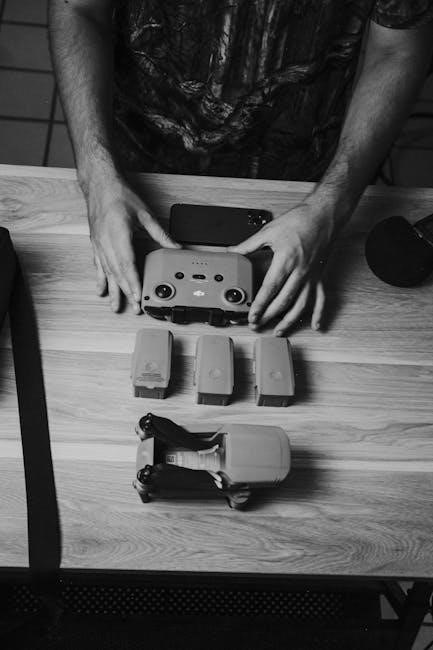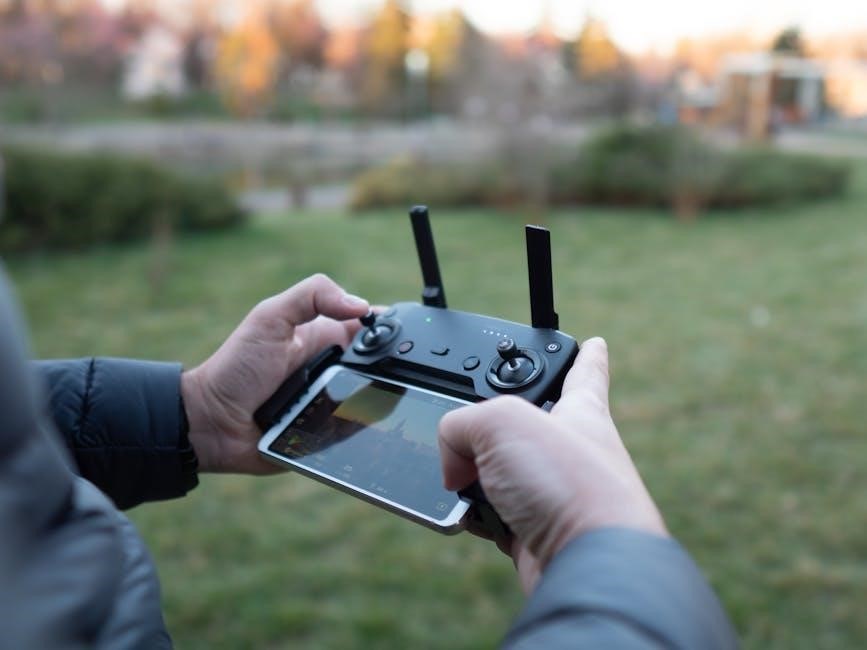Welcome to the KE2 Controller Manual, your comprehensive guide to mastering the product. This manual provides detailed insights into features, installation, operation, and troubleshooting, ensuring optimal use and understanding.
Overview of the KE2 Controller
The KE2 Controller is a sophisticated device designed to optimize industrial automation processes. It offers advanced temperature control, precise monitoring, and seamless connectivity options. Engineered for durability and efficiency, the controller is tailored for various applications, ensuring reliable performance in demanding environments. With its user-friendly interface and robust features, the KE2 Controller empowers users to achieve precise control and monitor operations effortlessly. This overview provides a foundational understanding of the device, preparing users to explore its capabilities in depth.
Importance of the Manual for Users
The KE2 Controller Manual is essential for users to unlock the full potential of their device. It provides clear guidance on installation, operation, and troubleshooting, ensuring smooth functionality.
By following the manual, users can optimize performance, understand advanced features, and resolve issues efficiently. It serves as a vital resource for both beginners and experienced users.
Structure and Content of the Manual
The KE2 Controller Manual is organized into clear sections, ensuring easy navigation. It covers installation, operation, features, troubleshooting, and maintenance, providing comprehensive guidance for all users.
Each chapter is designed to address specific aspects of the controller, from basic setup to advanced customization. Detailed diagrams, step-by-step instructions, and troubleshooting tips are included to enhance understanding and problem-solving.

Product Overview
The KE2 Controller is a high-performance device designed for precise control and monitoring in industrial applications, offering advanced features and robust design for reliable operation.
Key Features of the KE2 Controller
The KE2 Controller offers advanced temperature control, precise monitoring, and robust communication protocols. It features customizable programming, user-friendly interface, and compatibility with various industrial systems. Designed for reliability, it includes automation capabilities, real-time data analysis, and seamless integration with external devices. Its high-performance design ensures efficient operation in diverse applications, making it a versatile solution for industrial control needs;
Design and Build Quality
The KE2 Controller is built with durable, high-quality materials, ensuring long-term reliability in industrial environments. Its sleek, ergonomic design provides easy access to controls and a user-friendly interface. The robust construction withstands harsh conditions, while its compact size allows for flexible installation. Safety features, such as thermal protection and surge resistance, enhance operational reliability. The controller’s design prioritizes ease of use, with intuitive navigation and clear visual feedback, making it accessible for both novice and experienced users.
Compatibility and Applications
The KE2 Controller is designed for versatility, compatible with a wide range of industrial systems and software. Its adaptability makes it suitable for various applications, from temperature control in manufacturing to automation in laboratory settings. The controller seamlessly integrates with existing infrastructure, ensuring efficient operation across diverse industries. Whether for precision control or complex automation tasks, the KE2 Controller offers reliable performance, making it a valuable asset in multiple operational environments.

Installation and Setup
Welcome to the installation and setup section. This guide will walk you through the process of installing and configuring your KE2 Controller smoothly and efficiently.
Step-by-Step Installation Guide
Begin by unpacking the KE2 Controller and verifying all components are included. Mount the device in a secure, well-ventilated area. Connect the power supply and ensure all cables are properly secured. Install the KE2 Controller software from the provided source or download the latest version from the official website. Follow the on-screen instructions for software installation. Configure network settings if required. Once installed, perform a test run to ensure proper functionality. Finally, review the setup to confirm everything is operational.
Pre-Installation Considerations
Before installing the KE2 Controller, ensure the system meets all hardware and software requirements. Verify compatibility with existing equipment and check the power supply specifications. Ensure the installation environment is clean, dry, and well-ventilated to prevent damage. Review the manual for specific safety precautions and installation guidelines. Gather all necessary tools and accessories, such as cables and mounting hardware. Familiarize yourself with the controller’s documentation and ensure proper grounding to avoid electrical hazards. Plan the installation layout to optimize performance and accessibility.
Powering On and Initial Configuration
Connect the KE2 Controller to the power supply and ensure the voltage matches the specifications. Turn it on and observe the LED indicators for system status. Perform a self-test to verify functionality. Access the control panel to set the date, time, and language preferences. Navigate through the menu to configure basic settings, such as communication protocols and default parameters. Save your configurations and restart the system to apply changes. Refer to the manual for detailed instructions to ensure proper initialization and avoid errors during setup.

Operating the KE2 Controller
Master the KE2 Controller’s operation by understanding its control panel, navigating the menu system, and utilizing basic and advanced modes for efficient functionality and customization.
Understanding the Control Panel
The control panel is the central interface of the KE2 Controller, featuring buttons, displays, and indicators. It allows users to monitor and adjust settings, access menus, and execute commands. The layout is designed for intuitive navigation, with clearly labeled buttons for primary functions. The display provides real-time data, such as temperature, status messages, and error codes. Familiarize yourself with the panel’s components to efficiently operate the controller, adjust parameters, and troubleshoot issues. Proper understanding ensures smooth operation and maximizes functionality. Refer to the manual for detailed descriptions of each element and their purposes.
Navigating the Menu System
The KE2 Controller features an intuitive menu system designed for easy navigation. The main menu provides access to primary functions, while submenus offer detailed settings. Use the navigation buttons to scroll through options, selecting items by pressing the confirm button. The menu is organized into logical categories, such as configuration, monitoring, and diagnostics. Each section includes clear descriptions to guide users through adjustments. Familiarize yourself with the menu structure to efficiently access and modify settings, ensuring optimal performance. The system is designed to simplify complex tasks through organized and user-friendly navigation.
Basic and Advanced Operation Modes
The KE2 Controller offers two operation modes: Basic and Advanced. Basic mode simplifies control for routine tasks, providing pre-configured settings for easy operation. Advanced mode unlocks full customization, allowing users to adjust parameters, create custom profiles, and access specialized features. Switching between modes is done via the control panel or menu system. Advanced mode is ideal for experienced users or applications requiring precise control. Both modes ensure efficient operation, catering to different user needs and skill levels. Refer to the manual for detailed guidance on mode selection and utilization.

Features and Functions
The KE2 Controller features advanced capabilities, including customizable settings and intuitive operation. Its design ensures efficient control and adaptability to various applications, enhancing user experience and productivity.
Temperature Control and Monitoring
The KE2 Controller is equipped with advanced temperature control and monitoring features, enabling precise regulation and real-time tracking of temperature levels. The system offers customizable temperature settings, ensuring optimal performance across various applications. With its intuitive interface, users can easily monitor temperature data, receive alerts for deviations, and adjust parameters to maintain desired conditions. This functionality is crucial for applications requiring consistent and accurate temperature management, making the KE2 Controller a reliable solution for industrial and laboratory settings.
Communication Protocols and Connectivity
The KE2 Controller supports a wide range of communication protocols, including Ethernet, RS-232, and Modbus, ensuring seamless integration with external systems. Its connectivity options enable remote monitoring and control, allowing users to access and manage the controller from various devices. The system also supports wireless communication for added flexibility. These features facilitate data exchange, system synchronization, and real-time monitoring, making the KE2 Controller a versatile and efficient solution for industrial automation and process control applications.
Automation and Custom Programming
The KE2 Controller offers advanced automation capabilities, allowing users to create custom programs tailored to specific operational needs. With built-in programmable logic, the controller supports complex sequences and conditional operations. Custom programming enables precise control over temperature, timing, and other parameters, ensuring optimal performance in various applications. The system also supports integration with external devices, enhancing automation potential. Users can define custom profiles, set alarms, and automate responses, making it adaptable to diverse industrial and laboratory environments while ensuring efficient and reliable operation.

Customization and Configuration
The KE2 Controller allows users to customize control parameters, create custom profiles, and configure settings to meet specific requirements. Easy adjustments ensure adaptability and precise operation.
Adjusting Parameters and Settings
Adjusting parameters and settings on the KE2 Controller allows for precise customization. Access the control panel to modify temperature, timing, and sensitivity. Use the menu system to navigate to the desired settings. Refer to the manual for guidance on advanced configurations. Ensure changes are saved to maintain customized profiles. Regularly review settings to optimize performance and adapt to new requirements. Always follow safety guidelines when making adjustments to avoid system errors or malfunctions. Proper configuration ensures efficient and reliable operation.
Creating Custom Programs and Profiles
Creating custom programs and profiles on the KE2 Controller enables tailored functionality. Use the menu system to define specific operational parameters, such as temperature thresholds, timing sequences, and input/output configurations. Save these setups as unique profiles for quick access. Access advanced configuration options to fine-tune programs for precise control. Refer to the manual for step-by-step guidance on creating and managing custom programs. Regularly test and refine your programs to ensure optimal performance and adaptability to changing requirements. This feature maximizes the controller’s flexibility and efficiency in various applications. Always save changes to avoid data loss. Properly organized profiles enhance operational consistency and productivity. Follow manual instructions for troubleshooting custom programs. Regular updates may introduce new customization options, so check the manual for details. By leveraging custom programs, users can achieve highly specific control and automation, making the KE2 Controller adaptable to unique needs. Ensure all custom settings align with safety guidelines to prevent errors or system malfunctions. Custom profiles can be shared or transferred for consistency across multiple units. Explore the full potential of customization to streamline operations and improve results. Always refer to the manual for advanced customization techniques and best practices. This ensures reliable and efficient operation of the KE2 Controller in any application. Custom programs and profiles are essential for maximizing the controller’s capabilities and meeting specific operational demands. Regularly review and update custom settings to maintain optimal performance. Use the manual as a reference for troubleshooting and optimizing custom configurations. By doing so, users can fully utilize the KE2 Controller’s advanced features and achieve their desired outcomes. Customization is a key feature that sets the KE2 Controller apart, offering unparalleled flexibility and control. Always follow the manual’s guidelines when creating and managing custom programs and profiles to ensure safety and effectiveness. This approach guarantees that the controller operates at its full potential, delivering precise and reliable results.
Integrating with Other Systems
Integrating the KE2 Controller with other systems enhances its functionality and streamlines operations. Use communication protocols like Ethernet, USB, or RS485 to connect to external devices. Software integration with SCADA systems or IoT platforms is also supported, ensuring seamless data exchange and control. Refer to the manual for configuration steps and compatibility guidelines. Proper setup ensures reliable performance and prevents errors. Regularly test integrations to maintain optimal functionality and adaptability in diverse applications.

Troubleshooting Common Issues
Troubleshooting involves identifying and resolving errors. Check connections, review error codes, and restart the controller if necessary. Consult the manual for detailed solutions and guidelines.
Identifying and Diagnosing Problems
Identifying issues with the KE2 Controller begins with observing symptoms like error codes, unusual behavior, or system malfunctions. Review the control panel for warning messages or blinking indicators. Check connections and ensure all cables are securely attached. Consult the manual to interpret error codes and understand their meanings. Perform basic diagnostic tests, such as restarting the controller or resetting default settings. Systematic troubleshooting helps isolate the root cause, enabling effective resolution. Always refer to the manual for specific guidance tailored to the KE2 model.
Resolving Error Codes and Alarms
Resolving error codes and alarms on the KE2 Controller involves acknowledging the issue and addressing its cause. Start by reviewing the error code description in the manual to understand the problem. Perform corrective actions, such as adjusting parameters or replacing faulty components. Clear the alarm via the control panel once resolved. If issues persist, reset the controller or restore default settings. For critical errors, contact technical support for professional assistance. Always document the error and resolution for future reference.
Resetting and Rebooting the Controller
Resetting and rebooting the KE2 Controller can resolve software-related issues. To reset, navigate to the system menu and select “Factory Reset.” This will restore default settings but may erase custom configurations. For a hard reboot, disconnect the power supply, wait 10 seconds, and reconnect. Ensure all data is backed up before performing a reset. If issues persist after rebooting, consult the manual or contact support. Regular reboots can optimize performance and stability.

Maintenance and Upkeep
Regular maintenance ensures optimal performance and longevity of the KE2 Controller. Perform routine checks on connections, clean dust from vents, and update firmware as needed.
Regular Maintenance Tasks
Perform routine checks on all electrical connections to ensure they are secure and free from corrosion. Clean dust and debris from vents and fans to prevent overheating. Calibrate sensors and transducers as specified to maintain accuracy. Check for loose screws or components and tighten them if necessary. Replace worn-out seals or gaskets to prevent leaks. Inspect cables for damage and replace them if compromised. Schedule these tasks every 3-6 months to ensure optimal performance and reliability.
Updating Firmware and Software
Regularly update the KE2 Controller’s firmware and software to access new features, bug fixes, and performance improvements. Download the latest versions from the official website or through the KE2 Controller Software Utility. Before updating, back up your current configurations to prevent data loss. Follow the on-screen instructions carefully, ensuring the controller is connected to a stable power source. Avoid interrupting the update process to prevent corruption. Updated firmware enhances functionality and compatibility, keeping your system optimized for peak performance. Visit the support page for detailed update instructions.
Cleaning and Inspecting the Controller
Regular cleaning and inspection of the KE2 Controller ensure optimal performance and longevity. Power down the device before cleaning to avoid damage. Use compressed air to remove dust and debris from vents and surfaces. Inspect for signs of wear, corrosion, or damage to connectors and cables. Clean any corrosion using a soft-bristle brush and electrical contact cleaner. Replace damaged components promptly to prevent malfunctions. Schedule inspections every 6 months or as needed based on usage and environmental conditions. Refer to the manual for detailed cleaning procedures and safety guidelines.

Safety Precautions
Adhere to safety guidelines to prevent injury or damage. Always disconnect power before servicing. Avoid exposure to hazardous environments. Follow proper handling and emergency protocols.
General Safety Guidelines
Always follow safety protocols to ensure safe operation of the KE2 controller. Wear protective gear, including gloves and safety glasses, when handling electrical components. Ensure the controller is installed in a well-ventilated area, away from flammable materials. Avoid operating the device in hazardous environments. Keep the controller out of reach of children and unauthorized personnel. Follow all instructions provided in the manual. Never modify the controller without authorization, as this could void the warranty or cause malfunctions. Regularly inspect for signs of wear or damage and address issues promptly.
Handling Electrical Components
When handling electrical components of the KE2 controller, ensure the power is disconnected to prevent electrical shock. Use insulated tools to avoid direct contact with live circuits. Ground yourself by wearing an anti-static wrist strap or touching a grounded metal object. Avoid touching components with bare hands to prevent damage from static electricity. Inspect wires and connectors for damage before use. If soldering, ensure the area is well-ventilated and use proper soldering techniques. Always refer to the manual for specific instructions on handling sensitive electrical parts.
Emergency Shutdown Procedures
In case of an emergency, immediately press and hold the emergency stop button located on the front panel. This will halt all operations and power to the controller. Disconnect the main power supply by switching off the circuit breaker or unplugging the unit. Ensure all personnel are clear of the area. Do not attempt to restart the controller until the issue is resolved. Refer to the manual for specific procedures and consult technical support if necessary.

Resources and Support
For additional guidance, refer to the official KE2 Controller manual PDF. Contact customer support for technical assistance, or visit online forums for user discussions and solutions.
Accessing the Official Manual PDF
The official KE2 Controller manual PDF is available for download from the manufacturer’s website. To access it, navigate to the support section, enter your product details, and follow the download link. Ensure you have the correct model number to retrieve the accurate manual. The PDF provides comprehensive guidance, including installation, operation, and troubleshooting. For assistance, contact the support team via email or visit the official help page. This resource ensures you have all the information needed to operate the controller effectively.
Customer Support and Assistance
The KE2 controller manual PDF is backed by dedicated customer support. Users can contact the manufacturer’s support team via phone, email, or live chat for assistance. Additional resources include online forums and FAQs. The support team is available to address technical inquiries, troubleshooting, and operational guidance. For complex issues, escalation to specialized experts is possible. This ensures comprehensive assistance, enhancing the user experience with the KE2 controller. The support system is designed to resolve issues efficiently, minimizing downtime. Reach out for personalized help anytime.
Online Communities and Forums
Online communities and forums for the KE2 controller provide valuable resources and peer support. Discussion boards allow users to share knowledge, ask questions, and learn from experts. These platforms are great for troubleshooting, tips, and best practices. They often feature tutorials, user content, and real-time collaboration. Engaging with these forums enhances your understanding and maximizes the controller’s efficiency, fostering continuous learning and improvement.
Final Tips for Effective Use
To maximize the KE2 controller’s performance, ensure regular firmware updates and maintain organized backup schedules. Explore advanced features gradually to avoid overwhelming the system. Always refer to the manual for clarity on complex operations. Engage with online forums for shared insights and troubleshooting. Keep the controller clean and well-ventilated to prevent overheating. By following these tips and adhering to safety guidelines, users can optimize efficiency, extend lifespan, and achieve precise control over their applications.
Maximizing the Controller’s Potential
To unlock the full capabilities of the KE2 controller, explore its advanced features and experiment with custom profiles. Regularly update the firmware to access new functionalities. Leverage the controller’s connectivity options for seamless integration with other systems. Monitor performance metrics to fine-tune settings for optimal efficiency. Engage with the user community to discover innovative applications. By consistently exploring and adapting, users can unlock the controller’s maximum potential and achieve superior results in their operations.




Leave a Reply
You must be logged in to post a comment.